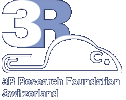 |
de | fr | en print view![]()
3R-Project 58-97
Development of laboratory housing conditions preventing stereotypic behaviour in Mongolian gerbils (Meriones unguiculatus)
Barbara König
Department of Animal Behaviour, Institute of Zoology, University of Zürich, 8057 Zürich, Switzerland
Hans Schmid
Nutz- und Zootierethologie, Zoologischer Garten Zürich, 8044 Zürich, Switzerland
bkoenig@zool.uzh.ch, eva.waiblinger@tiershutz.com
Keywords: gerbil; ethology: laboratory animals; ethology: enrichment
Duration: 3 years Project Completion: 2000
Background and Aim
This project focuses on the influence of housing conditions on the occurrence of stereotypic behaviour and its physiological correlates in laboratory gerbils. Stereotypies are generally viewed as behavioural disturbances, since they neither achieve an obvious goal nor fulfill a clear function. Housing conditions may overtax the adaptability of the animal’s behavioural repertoire, resulting in stereotypies, replacement activities, chronic stress and even bodily harm. So far, no consistent connections between housing conditions, stereotypies and chronic stress reactions have been found in laboratory rodents. The gerbil, although not one of the major laboratory rodent species, represents a suitable model to study these aspects.
The aims of this project are:
- assessment of the causes of stereotypic digging and bar-chewing in gerbils
- assessment of stress reactions induced by intensive housing conditions and/or stereotypies
- development of housing conditions which eliminate these causes and therefore prevent the development of stereotypies and chronic stress
Method and Results
Specific enrichment factors were added to standard housing conditions of laboratory gerbils. Their influence on the development of stereotypic behaviours and fecal cortisol levels was analyzed. Selected animals were observed weekly from their birth to adulthood, and frequency and duration of stereotyped behaviour bouts were protocolled. Fresh feces were noninvasively collected once weekly and assayed for Cortisol (RIA 125Iod-Cortisol). The present status of the project is as follows:
1. Stereotypic digging develops under standard housing conditions when juvenile gerbils are motivated to retreat into a burrow but cannot do so. An artificial burrow consisting of a darkened nest chamber outside the cage, accessible through a tunnel at the back of the cage, significantly reduced stereotypic digging in juvenile gerbils. The same burrow structure, not darkened and presented within the cage, however, failed to reduce stereotypic digging in juvenile and adult gerbils. Up to this point, no correlation was found between the measured fecal cortisol levels (ranging from 80-120 ng/mg feces dry matter) and age, housing conditions or stereotypy. An artificial burrow system was developed which significantly reduces the development of stereotypic digging and can easily be integrated in a standard laboratory cage type 4, covering one third of the available space. It consists of an opaque nestbox with angled access tube, a transparent separation wall and for stability reasons of an additional, transparent box accesible through a hole.
2. Bar-chewing cannot be viewed as a replacement activity caused by a lack of chewable nesting material nor does it result from reinforced bar-manipulation caused by the vicinity of food pellets and cage-lid bars in the food hopper. Neither the presence of nesting material (straw, paper towels) nor the location of the food, whether contained in the food hopper or scattered on the bedding, had an influence on the duration of bar-chewing. A significant rise in bar-chewing occurred after juvenile gerbils were separated from their families at the age of 35 days and transferred to a similar cage with fresh bedding in same-sexed littermate pairs. High levels of bar-chewing then persisted up to adulthood. This rise in bar-chewing might reflect the animals’ motivation to return to their families and home cages. We tested whether social separation from the family or transfer to a new cage caused the rise in bar-chewing. A significant rise in bar chewing occured in groups that were separated from their family before younger siblings are born. Transfer to a new cage had no significant influence on the development of bar-chewing. These results imply that laboratory gerbils should not be prematurely separated from their parents, at least not until a new litter of young siblings is born.
Conclusions and Relevance for 3R
Refinement of experimental procedures calls for animals free from chronic stress and abnormal, selfmutilating behaviour. Appropriate enrichment factors added to standard housing conditions combined with certain animal management measures can prevent the development of stereotypies in gerbils. At present it is still unclear whether stereotypic behaviour is a marker of chronic stress or whether it represents a coping strategy with a stress reducing effect.
(see also 3R-INFO-BULLETIN Nr. 16)
Published updated Version 16/2007 (pdf)
References
1. Waiblinger, E. and König, B. (1999): Do the presence of nesting material and the location of the food presentation have an effect on the development of bar-chewing in laboratory gerbils? KTBL-Schrift (ISBN 3-7843-2115X, Aktuelle Arbeiten zur artgemässen Tierhaltung 1999) 391: 178-186.
2. Waiblinger E. (2002): Comfortable Quarters for Gerbils in Reserach Institutions. In: Comfortable Quarters for Laboratory Animals (Ed. V. Reinhardt and A. Reinhardt), Animal Welfare Institute, Washington, DC 20007; Ninth Edition, 2002 (ISBN 0-938414-02-X); p.18 - 25. siehe auch: http://www.awionline.org/pubs/cq02/cqindex.html.
3. Waiblinger E. and König, B. (2004), Refinement of gerbil housing and husbandry in the laboratory, Animal Welfare, 13: 229-235.
4. Waiblinger E. and König, B. (2004), Refinement of gerbil housing and husbandry in the laboratory, ATLA 32; Supplement 1, 163-169.
4. Waibllinger E., König, B., Müller, L. and Schmid, H. (in prep): An artificial burrow system preventing the development of the digging stereotypy in laboratory gerbils, Animal Welfare.
5. Waiblinger, E. (in prep): Stereotypic digging and bar-chewing in laboratory gerbils - a test case for the current stereotypy definition? Applied Animal Behaviour Sciences.
| Last modified 2018/10/12 |